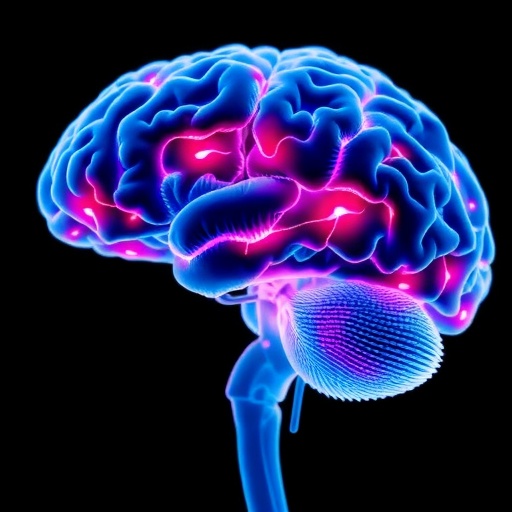Alzheimer’s disease, long recognized primarily as a devastating neurodegenerative disorder affecting the brain, is now revealed to have far-reaching impacts on the entire body. A groundbreaking study led by researchers at Baylor College of Medicine and the Jan and Dan Duncan Neurological Research Institute at Texas Children’s Hospital, in collaboration with multiple institutions, has challenged the traditional brain-centric view of Alzheimer’s. Utilizing the versatile model organism Drosophila melanogaster, commonly known as the fruit fly, this new research uncovers the systemic consequences of Alzheimer’s pathology, thereby opening new avenues for understanding and potentially treating this complex disease.
At the heart of Alzheimer’s disease lies the accumulation of toxic proteins within the brain. Amyloid beta 42 (Aβ42), which forms the characteristic amyloid plaques, and Tau, a microtubule-associated protein whose abnormal aggregates form neurofibrillary tangles, are hallmarks of the illness. However, this new work transcends previous investigations by examining not only the brain but also how these pathological proteins affect other tissues in the body. To achieve this, the team engineered Alzheimer’s disease fruit flies by selectively expressing human Aβ42 or Tau proteins exclusively in neuronal cells of adult flies. This targeted neuronal expression circumvents developmental confounders allowing the study of adult-onset effects related to the disease.
The researchers employed single-nucleus RNA sequencing (snRNA-seq) across the entire organism, creating an unprecedented Alzheimer’s Disease Fly Cell Atlas. This high-resolution cellular map profiles the transcriptomes of 219 distinct cell types from both the head and body of affected flies. The atlas provides a detailed molecular portrait revealing how Alzheimer’s pathological proteins disrupt cellular function well beyond neurons. By analyzing these datasets, scientists uncovered a dichotomy in how Aβ42 and Tau exert systemic influences, illuminating complexities in brain-body communication.
Expression of Aβ42 predominantly resulted in alterations confined primarily to the nervous system. Notably, sensory neurons responsible for critical modalities such as vision, hearing, and olfaction were particularly susceptible to Aβ42-associated toxicity. The loss of olfactory neurons aligns with clinical observations where hyposmia, or reduced sense of smell, is an early detectable symptom in human Alzheimer’s patients. This refined identification of vulnerable olfactory neurons offers promising insights into preclinical biomarkers and early intervention points.
The Alzheimer’s Disease Fly Cell Atlas represents a significant advance for the neurodegeneration research community, providing a comprehensive resource that deciphers Alzheimer’s impact across an entire organism with single-cell resolution. This tool enables researchers to explore the cellular and molecular crosstalk between brain pathology and peripheral organ systems in unprecedented detail. Such knowledge is critical for developing novel biomarkers that reflect systemic disease burden and for identifying therapeutic targets outside the brain, which might enhance treatment efficacy.
Beyond its immediate scientific contributions, this study underscores the power of Drosophila as a model for unraveling complex human diseases at the whole-organism level. The fruit fly’s conserved genetic pathways and amenability to genetic manipulation allow rapid, precise investigations into mechanisms and phenotypes relevant to human neurodegeneration. This work exemplifies how cutting-edge genomics technologies can transform classical model organisms into multifunctional platforms to dissect multifactorial diseases.
This research involved a broad team of experts from multiple institutions, including Baylor College of Medicine, the Jan and Dan Neurological Research Institute at Texas Children’s Hospital, National Yang Ming Chiao Tung University in Taiwan, University of Michigan, and U.T. Health San Antonio. Their interdisciplinary collaboration enabled the study’s technical sophistication and integrative approach, combining molecular genetics, neurobiology, and computational biology.
The implications of this discovery extend toward the development of systemic therapies aimed at counteracting Alzheimer’s disease not just within the central nervous system but throughout the body. Targeting peripheral tissues or modulating brain-body signaling circuits could hold the key to mitigating both cognitive decline and non-neurological symptoms that Alzheimer’s patients endure. Furthermore, profiling vulnerable cell types across organs might drive early diagnosis through novel biomarker panels detectable in accessible tissues or fluids.
Funding for this research was provided by prestigious grants from the National Institutes of Health (NIH) including the National Institute on Aging (NIA), the National Institute of General Medical Sciences (NIGMS), and private endowments such as the Huffington Foundation. Such extensive support reflects the critical importance and anticipated impact of understanding Alzheimer’s disease systemically.
In conclusion, this landmark study fundamentally reshapes the conceptual framework of Alzheimer’s disease. By revealing the distinct yet interconnected systemic impacts of Aβ42 and Tau proteins through an elaborate whole-body cellular atlas, the research paves the way for holistic approaches in diagnostics and therapeutics. The comprehensive molecular insights provided by this work promise to catalyze new strategies that address Alzheimer’s as a complex, multisystem disease rather than one confined solely to the brain.
Subject of Research: Animals
Article Title: Distinct systemic impacts of Aβ42 and Tau revealed by whole-organism snRNA-seq
News Publication Date: 16-May-2025
Web References:
Neuron Journal
DOI Link
Keywords: Life sciences, Cell biology, Genetics, Neuroscience, Organismal biology, Physiology
Tags: adult-onset Alzheimer’s researchAlzheimer’s disease systemic effectsAlzheimer’s pathology explorationamyloid beta 42 impactBaylor College of Medicine studybrain-body connectionDrosophila melanogaster modelneurodegenerative disorder researchneurofibrillary tangles studypotential Alzheimer’s treatmentstau protein aggregationTexas Children’s Hospital collaboration





